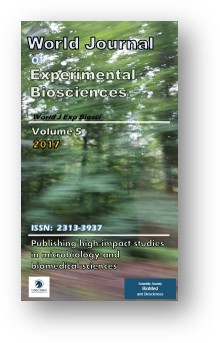Antibacterial and Cytotoxicity of Silver Nanoparticles Synthesized in Green and Black Tea
Keywords:
Antibacterial activity, Cytotoxic, Green and black tea extracts, Green synthesis, Silver nanoparticles.Abstract
In this study, silver nanoparticles (AgNPs) have been successfully synthesized using green and black tea in a facile and inexpensive environmentally friendly process. The green and black tea extracts were verified to contain phytochemicals such as alkaloids, flavonoids, saponins, phenols and steroids. These phytochemicals in green and black tea served as reducing agent and as stabilizing and capping agents for the microwave-assisted synthesis of AgNPs from AgNO3. The formation of the AgNPs were established by ultraviolet–visible spectroscopy (411 and 420 nm) and the physical was established with scanning electron microscopy (SEM) which indicated that the nanoparticles were spherical in shape with diameter between 30 nm and 50 nm. Different AgNPs concentrations of 680, 340, 170, 85 and 42.4 μg/disc were tested. AgNPs inhibited growth of Escherichia coli and Staphylococcus aureus. Half maximal inhibitory concentration (IC50) of AgNPs (with and without infusion of tea) by (3-(4,5-dimethylthiazol-2-yl )-2,5-diphenyltetrazolium bromide) tetrazolium reduction assay MTT (μM ) that was required for 50% inhibition after 72 h was found at 400 to 454 μg /mL. AgNPs did not show any cytotoxicity against chicken embryo fibroblast cells. Tea extracts produced AgNPs showed promise as a nontoxic alternative for biological applications.
Downloads
Published
Issue
Section
License

This work is licensed under a Creative Commons Attribution-NonCommercial-NoDerivatives 4.0 International License.
All articles in the World Journal of Experimental Biosciences are published under the terms of the Creative Commons Attribution 4.0 International License (CC BY 4.0), which permits unrestricted use, distribution, and reproduction in any medium, provided the original work is properly cited.






